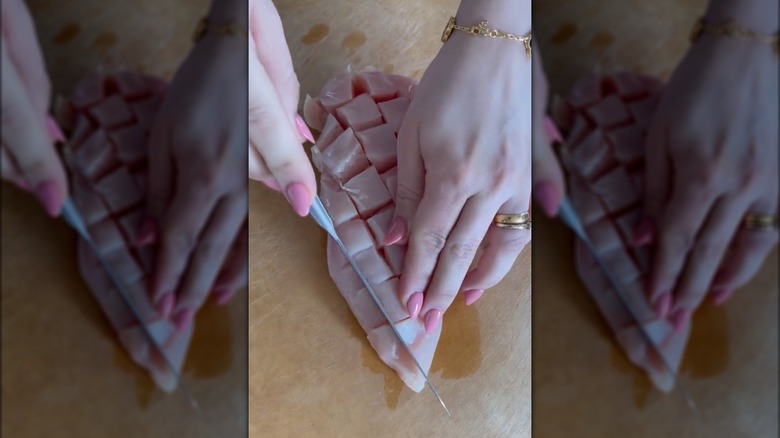The Reason You Should Start Cutting Chicken Like A Mango
Usually when you whip up a chicken breast recipe, you marinade the outside and toss it all in the oven to cook. Best case scenario, you wind up with chicken that's well-seasoned outside and, well, not so well-seasoned inside. Worst case scenario, you're left with a flavorless and dried-out chicken breast. Gross.
That being said, chicken breasts don't have to be bland and dry –- it's all about the method of preparation. Rather than slather the outside of the chicken with a marinade and hope it seeps in, you should poke holes in uncooked chicken breast. Or, better yet, cross-hatch it like you would a mango. Both of these tricks increase the surface area exposed to your marinade or seasoning, meaning you'll get a much better flavor payoff.
Cross-hatching your chicken also allows for a more even cook, as the heat from the oven no longer has to penetrate a thick slab of meat. As such, the chicken can better retain its moisture, no longer subjecting you to dried-out chicken.
Tips for cross-hatching your chicken
Although cross-hatching a piece of chicken seems simple, there are a few things to take into consideration so you get the best results. After all, what's the point in scoring your chicken if the way you do it doesn't actually help you in the end?
First, you'll want to make several cuts in both directions (or at the very least, several cuts in one direction), each about half an inch apart, to allow for sufficient seepage of your marinade. These cuts should be between an eighth of an inch and a quarter of an inch deep for the best results. Of course, the biggest mistake you can make with chicken breasts is scoring them too deeply, letting all the moisture escape during cooking.
Alternatively, if you find the cross-hatch method too daunting, you can use the poking method. Similar rules apply, with your holes aiming to be about half an inch apart for even marinade distribution. Either way, your chicken will thank you.

